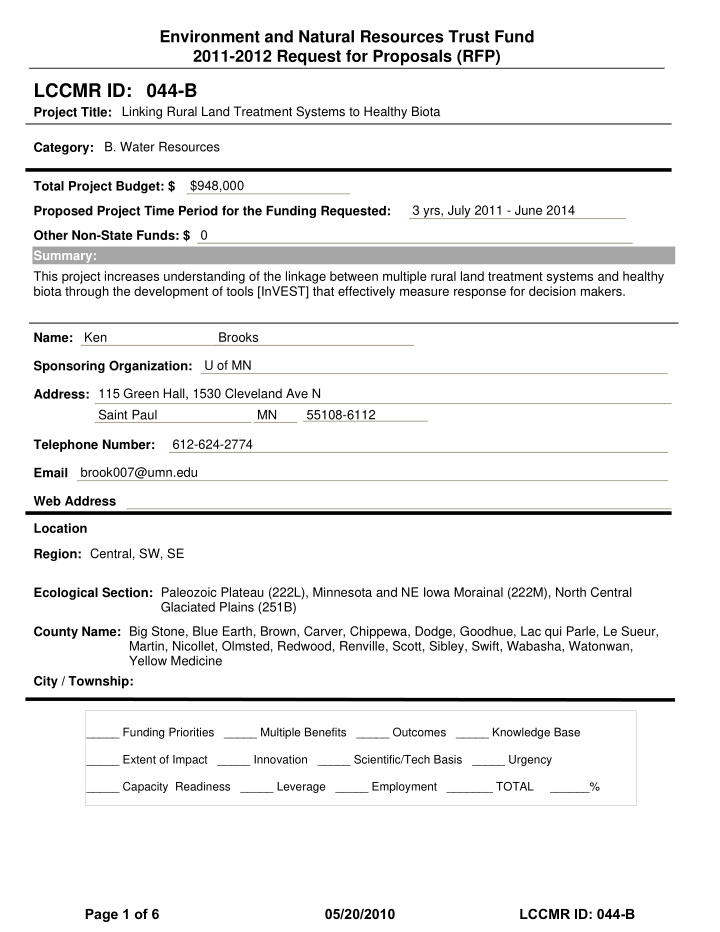



Environment and Natural Resources Trust Fund 2011-2012 Request for Proposals (RFP) LCCMR ID: 044-B Project Title: Linking Rural Land Treatment Systems to Healthy Biota Category: B. Water Resources Total Project Budget: $ $948,000 Proposed Project Time Period for the Funding Requested: 3 yrs, July 2011 - June 2014 Other Non-State Funds: $ 0 Summary: This project increases understanding of the linkage between multiple rural land treatment systems and healthy biota through the development of tools [InVEST] that effectively measure response for decision makers. Ken Brooks Name: U of MN Sponsoring Organization: 115 Green Hall, 1530 Cleveland Ave N Address: Saint Paul MN 55108-6112 612-624-2774 Telephone Number: brook007@umn.edu Email Web Address Location Central, SW, SE Region: Ecological Section: Paleozoic Plateau (222L), Minnesota and NE Iowa Morainal (222M), North Central Glaciated Plains (251B) Big Stone, Blue Earth, Brown, Carver, Chippewa, Dodge, Goodhue, Lac qui Parle, Le Sueur, County Name: Martin, Nicollet, Olmsted, Redwood, Renville, Scott, Sibley, Swift, Wabasha, Watonwan, Yellow Medicine City / Township: _____ Funding Priorities _____ Multiple Benefits _____ Outcomes _____ Knowledge Base _____ Extent of Impact _____ Innovation _____ Scientific/Tech Basis _____ Urgency _____ Capacity Readiness _____ Leverage _____ Employment _______ TOTAL ______% Page 1 of 6 05/20/2010 LCCMR ID: 044-B
LCCMR – 2010 University of Minnesota and Rural Advantage – Priority B- 1, 2 & 3; priority C–1. I. PROJECT STATEMENT Minnesota plans to focus on biotic indices to define water quality impairments. Based on past observation, approximately 40% of the waterbodies assessed will not meet standards. The MPCA will be faced with the task of mitigating thousands of water bodies that have impaired biota. Developing the means of improving water quality and aquatic biota is particularly challenging for streams and rivers that have been impaired by non-point source (NPS) pollution in agricultural watersheds. Effective treatment options for addressing NPS pollution are not presently in hand. To date, extensive monitoring and research (with support from CSREES, LCMR, and MPCA funding) have helped determine causes of water quality impairment and have identified practices that have potential to reduce turbidity, sediment and nutrient impairment from agricultural watersheds including BMPs such as riparian buffers. However, none have examined the complementary aspects of multiple land-use practices applied across the landscape to address multiple impairments and that ultimately improve aquatic biota (Meals et al. 2010). Restoring aquatic biota requires new ideas and integrated land management across the landscape to improve water flow, water quality, and aquatic habitat to meet standards for fishable and swimmable conditions. What is needed are: (1) integrated land treatment systems that can cumulatively improve water quality and aquatic biota; and (2) effective user-friendly tools for land managers to identify the type and location of land treatment systems to effectively and efficiently improve impaired waters. The goals of this research are to (1) determine the cumulative effects of rural land treatment systems to improve aquatic biota and meet water quality goals in the Chippewa, greater Blue Earth and Cannon River basins, (2) develop "effectiveness monitoring" tools that link biotic response to designed treatment systems to limit pollutant impact upon fish and macroinvertebrates, and (3) engage multiple stakeholders through demonstration and training to enable them to apply the tools in their land conservation work. This research takes an integrated watershed management approach and applies a set of decision-support tools (e.g., computer modeling platforms such as InVEST) that will assist agency personnel and other stakeholders in identifying causes of impaired waters and target land use treatments on “working lands”. By addressing working lands, we target the vast majority of agricultural lands recognizing that land retirement programs alone cannot treat sufficient land areas to address impaired waters across the state. II. DESCRIPTION OF PROJECT ACTIVITIES Activity 1. Determine the effects of rural land treatment systems to improve aquatic biota $378,000 (1) Based on past and continuing monitoring and research on watersheds in the Chippewa, greater Blue Earth, and Cannon River basins, establish relationships that link each of the following land use treatments for agricultural landscapes with aquatic biota and related water quality constituents. (a) Two – stage ditches -- applications of newly designed 2-stage ditches coupled together with previously used buffer strips to "tailor fit" a landscape and provide cumulative impacts of improving aquatic biota habitat and reducing sediment, turbidity and nutrient export along large ditches; (b) Application of cover crops on corn-soybean fields to reduce surface runoff and soil erosion, (c) Interceptor wetlands (biogeochemical reactors) restored along stream corridors that intercept tile drainage and reduce NO3, TP and organic sources of turbidity, and (d) Perennial cropping and agroforestry systems located in selected areas that can provide habitat and financial returns to landowners (e.g., bioenergy, forage for livestock, others). (2) Continue monitoring of existing sites in the greater Blue Earth basin through 2011-2014 to test and validate computer model results. Outcome Completion Date 1. Relationships between treatment systems on impaired water impacts January, 2014 2. Report on monitoring (will include annual summaries) June, 2014 Activity 2: Develop effectiveness monitoring tools -- $181,500 Develop submodel components for the InVEST modeling platform (Tallis et al., 2010), validate the model with data sets from each of the three watersheds, and apply by examining the cumulative effects of different Page 2 of 6 05/20/2010 LCCMR ID: 044-B
Recommend
More recommend